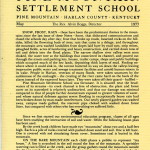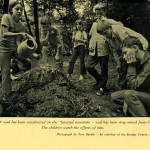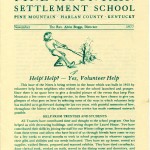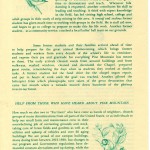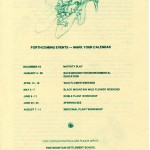Pine Mountain Settlement School
Series 17: PUBLICATIONS PMSS
NOTES 1977
May and November
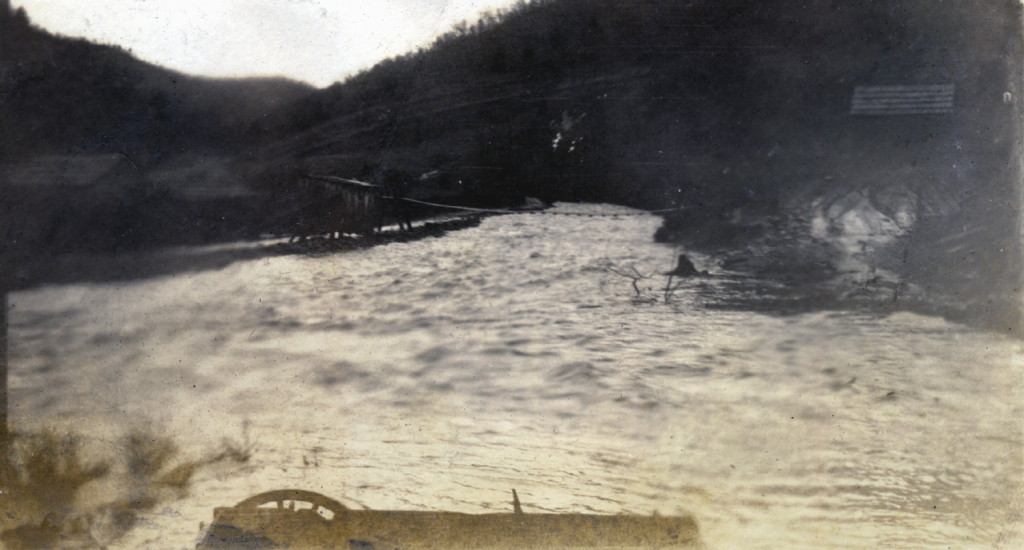
“In the Days of High Tides. – Big Laurel.” Greasy Creek at flood stage. Junction of Laurel and Greasy Creeks. [nesb_063_mod.jpg]
NOTES – 1977
“Notes from the Pine Mountain Settlement School”
May and November 1977
GALLERY: NOTES – 1977 May
[Concerning an experiment conducted by Environmental Education students on the destructive force of floods] One adult visitor said, “I wish our senators and congressmen could see this lesson.”
- NOTES – 1977 May, page 1. [PMSS_notes_1977_may_0011.jpg]
- NOTES – 1977 May, page 2. [PMSS_notes_1977_may_0012.jpg]
- NOTES – 1977 May, page 3. [PMSS_notes_1977_may_0013.jpg]
- NOTES – 1977 May, page 4. [PMSS_notes_1977_may_0014.jpg]
TAGS: Notes – 1977 May, snow, frost, floods, environmental education, advantages of a forested mountain, emotionally disabled children’s program, visitors to PMSS, workshops, events, college courses, fundraising
TRANSCRIPTION: NOTES – 1977 May
P. 1
NOTES FROM THE
PINE MOUNTAIN
SETTLEMENT SCHOOL
PINE MOUNTAIN * HARLAN COUNTY * KENTUCKY
May The Rev. Alvin Boggs, Director 1977
SNOW, FROST, RAIN — these have been the predominant themes in the mountains since the last issue of these Notes — Snow, that dislocated communications and closed the schools day after day; frost that broke up roads, loosened rocks on the hillsides, killed the flowering buds of trees; rain that came in a deluge, and throughout the mountain area washed landslides from slopes laid bare by road cuts, strip mines, ploughed fields, acres of lumbering and heavy construction, and carried down tons of soil and debris into the flood plains. The narrow shallow river valleys were soon choked, the water tore at the buildings that constricted its channel, and poured out through the streets and parking lots, houses, trailer camps, shops and public buildings which occupied much of the low lands, depositing thick layers of mud. Finding nowhere where it could sink in, the torrent battered its way on down the valleys leaving inoperative public water and sewage treatment facilities and untold human misery in its wake. People in Harlan, veterans of many floods, were taken unawares by the suddenness of the onslaught — the cresting of the river came hard on the heels of the alarm instead of the expected hours later. They were taken off their guard — baffled — Pine Mountain Settlement School was fortunate. It is situated near the headwaters of its streams — its creek channel is free of obstruction, the plant and forest cover on its watershed is relatively undisturbed, and thus our damage was minimal compared to that of people further downstream exposed to greater volumes of water, and whose natural defenses against severe flooding in exceptionally heavy rain had been broken down by man-made interferences. Our newly planted garden was washed away, campus roads gullied, the reservoir pipe choked with washed down forest litter, but compared with others who lost everything we suffered little.
**********
Since we first started our environmental education program, classes of all ages have been studying the interaction of soil and water. Often the following lesson plan has been used.
By the creek bank children have made two “mountains” about two and a half feet high. Each is a pile of rocks covered with packed down sand and soil. One is left bare. One is covered with sod simulating forest cover. Sometimes coal is buried in this mountain.
ON THE BARE MOUNTAIN each child places a pebble to represent “my house.” A line is scratched in the soil round the foot of the mountain. A sprinkler watering can is filled at the creek, and the group gathers round the mountain outside the line to watch the effect of rain on the mountain top. How long does it take the water to run down the mountain and cross the line? Usually 5-7 seconds. How much water have we used? A third to half a can. The water that reaches the foot of the mountain is so thick with silt that you can pick it up. We continue to pour “rain,” sometimes trying the effect of a “cloudburst.” The “houses” at the top of the mountain stand among soil-less rocks and pebbles, no hope for gardens or re-afforestation there – the soil is gone. Who can put it back? Houses on the slopes have been washed down the hillside or fallen into gullies. Those at the foot of the mountain are buried in mud. The water has come and gone — flash flood — drought.
P. 2
ON THE SOD-COVERED OR “FORESTED” MOUNTAIN, “houses” are placed, the line round the bottom drawn and water is poured. How long does it take to reach the line? It averages about 55 seconds, nearly eight times as long as on the bare mountain. How much water does it take to reach the line? A whole can, sometimes a can and a half — three times as much water as on the bare mountain. When it trickles out of the mountain the water is clear of mud. It continues to run out gently after the rain has stopped. No flash flood/drought cycle here. There is still soil at the top of the mountain, there are no gullies on its sides, and the houses are still in place. No great gobs of mud surround the foot of the hill. We try a cloudburst — it makes little appreciable difference.
Sometimes, as in the picture, we “bulldoze” a road up the forested mountain, cut off the overburden above our coal and strip mine it out. Again we try pouring water on this mountain (these children are noting the effects).
We then pour water again and try to discover exactly what happened. We notice the shatter-spatter action of rain on bare ground, and then how leaves deflect and break the fall of the water, how plant material acts as a sponge to retain it, and how roots hold the soil. Wordlessly these mountains teach their lesson.
From this point the lesson may raise many speculations.
What actions of man destroy the plant cover and disturb the soil? Which is ultimately more important to man’s well being: soil or the dollar bill?
How many civilizations have passed away after they have destroyed their forested watersheds?
Has anyone anywhere come up with an alternative method that can insure as steady a delivery of life-giving water to the farms and cities of the plains as efficiently and economically as a forested mountain?
If we must disturb any of the forested cover on our mountains, what steps can we take to hold the damaging effects to a minimum?
And, in the last few weeks, what does this experiment tell us about the suddenness and destructive force of the recent floods?
One adult visitor said, “I wish our senators and congressmen could see this lesson.” Yet both before and after the flood many youngsters from this area have at least given some thought to these matters.
P. 3
[Image with caption: “A road has been constructed on the ‘forested mountain ‘– coal has been strip mined from it. The children watch the effects of rain.”
Photograph by Tom Hardin by courtesy of the Sunday Courier Journal Magazine]
P. 4
THE EMOTIONALLY DISTURBED CHILDREN’S PROGRAM
“Add 8 and 5.”
“I can’t.”
“Yes, you can. You’ve done things like this before.”
“I can’t.”
“Why?”
“I don’t have enough fingers.”
In spite of the county schools having been closed for over thirty-five days for snow, icy roads or floods, the little group of emotionally disturbed children have had a happy progressive chance to learn and live together. Two have rejoined normal classes and are doing well. Two new students have taken their places. One is excited by the new world opened up by the hearing aid that his teachers have helped him obtain and use. Others have found speech therapy classes have made the outer world less obtuse to their efforts to communicate. All have discovered it is fun to work with people who care about you and have time for you.
**********
Since our last issue of the Notes over a thousand day visitors have come to share the Pine Mountain experience, and close on five hundred have been resident visitors for anything from one night to twenty-five nights. All have benefited from the closely inter-knit work of the farm and maintenance staff, the office staff, the teaching staff, the housekeeping, dormitory and catering staff. For it is in the whole impact of the experience here that the chief teaching lies, and not in words spoken in any given class. The visitors may not always realize it, but we on the staff are fully aware that much of the effectiveness of our work rests on the shoulders of the absentee staff — you, our supporters, whose generous gifts make possible the continuance of our work of trying to open the eyes of small children, boys and girls, young people and old folk from the mountain regions and from further afield — to the beauty, wonder, complexity and fragility of the world we live in. We thank you sincerely for what you have done for us in the past, and we trust in your continued support and interest for the future of our work — a small, but we believe vital, part of the future of the world.
**********
MARK YOUR CALENDAR!
MARK YOUR CALENDAR — Forthcoming Open Events, 1977
Edible Plants Workshop — June 6 – 10, 1977
Spinning Bee — June 17 19
Medicinal Plants Workshop — August 8 – 12
Pine Mountain Homecoming — August 13
Fall Color Weekend — October 14 -16
College Course — Culture in the Appalachian Environment — December 4 – 16, 1977
Nativity Play — December 18, 1977
College Course — Backgrounds for Environmental Education — January 4 – 28, 1978
Please mark your calendar. Write for particulars. Make reservations.
PINE MOUNTAIN SETTLEMENT SCHOOL
P.O. BLEDSOE, KENTUCKY 40810
Phone 606/558-4361
WE STILL NEED
Rived-board roofs for Old Log House and the Creech Cabin
New Roof for the Chapel
But most of all, funds for everyday expenses and sky-rocketing wage costs
GALLERY: NOTES – 1977 November
In these Notes [are] some of the ways in which volunteer help has enabled us to go forward during the last two years….
- NOTES – 1977 November, page 1. [PMSS_notes_1977_nov_001.jpg]
- NOTES – 1977 November, page 2. [PMSS_notes_1977_nov_002.jpg]
- NOTES – 1977 November, page 3. [PMSS_notes_1977_nov_003.jpg]
- NOTES – 1977 November, page 4. [PMSS_notes_1977_nov_004.jpg]
TAGS: Notes – 1977 November, volunteers, volunteer activities, Trustees, students, college terms, neighbors, alumni, visiting groups, gifts, drawings
TRANSCRIPTION: NOTES – 1977 November
P. 1
NOTES FROM THE
PINE MOUNTAIN
SETTLEMENT SCHOOL
PINE MOUNTAIN * HARLAN COUNTY * KENTUCKY
November The Rev. Alvin Boggs, Director 1977
[Image: Sketch of a boy clearing briars.]
Help! Help? — Yes, Volunteer Help
This issue of the Notes is being written in the house which was built in 1913 by volunteer help from neighbors who wished to see the school launched and prosper. Since there is no space here to give a detailed picture of the events that keep Pine Mountain a live center of ongoing service, in these Notes we have chosen to give you glimpses of what goes on here by selecting some of the ways in which volunteer help has enabled us to go forward during the last two years, with grateful memories of how, throughout the history of the school, volunteer service has made continued outreach possible.
HELP FROM TRUSTEES AND STUDENTS
All Trustees have contributed time and thought to the school program. One has helped us with decorating buildings, and sewing drapes for Laurel House. Two have contributed their skills by joining the staff for our Winter college terms. Seven students from these terms and others who have heard of us through friends have come to stay for a few weeks to several months to work in school programs in whatever capacity their gifts and abilities and our needs indicated. They have set up looms, sorted art supplies, washed fleeces, prepared and manned exhibits. They have dyed cornshucks, done clerical work, worked on trails, served in the dining room and dormitory, and registered guests for conferences. They have helped teach beginners’ swimming classes, milked cows, tended sick lambs, and worked as teachers’ aids in the class for emotionally disturbed children. All the time they have been studying and learning environmental lessons and preparing new ones so that they can take a large share in teaching the groups which come here day after day, week after week. Their aid has enabled us to keep classes small and personal.
P. 2
HELP FROM FORMER STUDENTS AND NEIGHBORS
[Image: Small sketch of a bird.]
Whenever we have a class that wants advanced spinning or cornshuck work, a neighbor has given time to demonstrate and teach. Whenever folk dancing is requested, another contributes his skill in leading and teaching. A third with expert knowledge in the field, has led visiting high school, college and adult groups in their study of strip mining in this area. A young and zealous former student has given much time to working with groups in the field. He is staff aid now, and hopes to go to college to prepare to make this his life work. Another former student, as a community service, coached a local ladies’ ball team on our grounds.
Some former students and their families arrived ahead of time to help prepare for the great annual Homecoming which brings former students and workers from every decade of the school’s life to reminisce, and express their joy and gratitude for everything Pine Mountain has meant to them. The early arrivals cleared weeds from around buildings and from walkways, washed windows, cleaned and decorated the Chapel, prepared guest rooms, remembering the days when as students they worked at similar tasks. A former student led the fund drive for the chapel organ repair, and put in hours of work until the goal was reached. Another piloted the helicopter from which photographs were taken of the great devastation that came last month when a tornado mowed down hundreds of the glorious trees in our forest.
HELP FROM THOSE WHO HAVE HEARD ABOUT PINE MOUNTAIN
How much we also owe to “Furriners” who have come as bands of neighbors, church groups of many denominations from all parts of the United States, or as individuals to help our small farm and maintenance crew in their overwhelming job of overseeing grounds and stock, taking care of forest fields and gardens as well as of utilities and upkeep of vehicles and over 20 aging buildings! We are proud of our campus buildings, many dating from between 1913-1930, but changes in our program and Government regulations have demanded constant alterations and updating, while the structure needs constant maintenance — pans to catch drips from leaking roofs are far from ideal. The visiting work groups have lightened the load. They…
[Image: Small sketch of ladybugs on a plant.]
P. 3
…have painted buildings, renovated floors, done cement work on regulation fire escapes, repaired and painted the swimming pool among other maintenance jobs. For the farm and grounds they have worked in field and garden and helped to clear land of ever encroaching briars. A womans’ group has stitched at home to keep our linen supply going. Individuals from this area and farther afield, businessmen, Amish farmers and their wives have given expert help in such jobs as rewiring buildings, rebuilding the cane mill, restoring West Wind terrace, building a coal bin, donating and transporting needed lumber and coal.
[Image: Small sketch of a bird.]
These are some of the unsolicited gifts of time and talent that we have received. We cannot here enumerate gifts in cash and kind or even the volunteer hours put in by our campus residents in all phases of the program.
We feel a little like the man in the old tale of “stone soup.” He wanted to treat his neighbors to a meal, but all he had was water in the kettle and a fire. He put a stone in the kettle and told his friends there would be soup. Each guest brought a contribution to the pot and by the time the company was assembled a good nourishing soup was served.
Our heritage from those who preceded us, the dedication of the present day staff denote a readiness to nourish a neighborhood, a country, a world. The tale of the volunteer helpers shows that their work has hugely enriched the offering. We are ever mindful that all those who have contributed gifts in kind and money contributed a vital ingredient which provides salaries for permanent workers, supplies, and current expenses which enable Pine Mountain to make use of the gifts of service. Whether we know you as a person or as a name, those of you who have made contributions in the past and continue to do so are truly a part of this enterprise. What you are able to contribute to the pot will help ensure that Pine Mountain will continue to offer the nourishment so needed by society today — vision, insight, and an understanding heart — to all who pass this way.
[Image: Small sketch of an owl and its owlet on a branch.]
P. 4
[Image: Sketch of a frog on a leaf.]
FORTHCOMING EVENTS — MARK YOUR CALENDAR
DECEMBER 18 NATIVITY PLAY
JANUARY 4 – 28 BACKGROUND FOR ENVIRONMENTAL EDUCATION
APRIL 14 – 16 WILD FLOWER WEEKEND
MAY 5 – 7 BLACK MOUNTAIN WILD FLOWER WEEKEND
JUNE 9 – 11 EDIBLE PLANT WORKSHOP
JUNE 23 – 25 SPINNING BEE
AUGUST 7 – 11 MEDICINAL PLANT WORKSHOP
**********
FOR FURTHER PARTICULARS PLEASE WRITE:
PINE MOUNTAIN SETTLEMENT SCHOOL
PINE MOUNTAIN, KENTUCKY 40810
OR CALL 606/558-4361
Previous:
NOTES – 1976
Next:
NOTES – 1978
See Also:
BUILT ENVIRONMENT Guide
EVENTS Guide
ENVIRONMENTAL EDUCATION Guide
HISTORY PMSS Summary 1976-1977
HISTORY PMSS Summary 1977-1978
Return To:
NOTES Index

